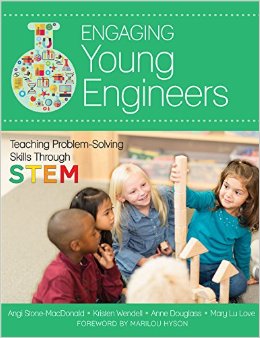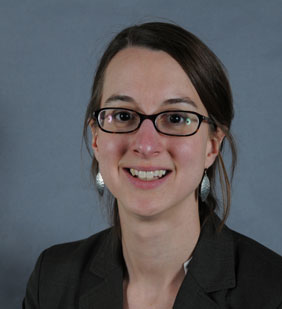
Kristen Wendell, CEEO alumna and Assistant Professor of Education at UMASS Boston, recently co-authored the book Engaging Young Engineers: Teaching Problem-Solving Skills through STEM. Focused on early childhood (birth to age 5), the book offers theoretical and practical resources for parents and educators. Wendell explains the book’s origins: “Aware of the kind of work I had done at the CEEO, three early childhood education professors at UMASS invited me to collaborate with them in thinking about how to bring STEM in an inclusive way to early childhood settings, even to infant and toddler groups.”
The book begins with a theoretical framework that even infants can engage in “emergent engineering” problem-solving behaviors. Citing research and practical examples, the authors identify four developmentally appropriate phases of engineering design: 1) Think about it 2) Try it 3) Fix it 4) Share it. They map these behaviors to those of professional engineers and affirm that “kids can” engage in engineering behaviors.
The authors also discuss five “higher order thinking skills” that are essential for engineers and young problem solvers”: Curious Thinking, Persistent Thinking, Flexible Thinking, Reflective Thinking, and Collaborative Thinking. They explain how these contribute to phases of engineering design and describe how they inform one another.
Building on these theoretical foundations, the authors move on to discussing how parents and educators can facilitate meaningful engineering problem-solving experiences, even for the youngest learners. As Wendell explains, “we worked hard to develop our approach to inclusive early STEM through engineering, and we set out to develop and test activities with expert early childhood teachers in the city of Boston.”
Wendell and her co-authors provide resources based on Universal Design for Learning, a framework for inclusive and flexible curriculum planning. They pose questions for teachers to consider and they offer suggestions about how to support different kinds of learners, including those with special needs.
They also unpack each of the 5 “thinking skills.” For each one, they provide practical resources and suggest infant, toddler, and preschool activities that were tested in early childhood classrooms. Some of these activities, like an engineering challenge based on the book Muncha, Muncha, Muncha, will be familiar to those who have tried CEEO’s Novel Engineering project. Wendell says, “What I learned at the CEEO influences everything I do- from the design challenges I pose, to the LEGO materials I offer, to the strategies I use for facilitating small-group discussions.” Other challenges, like a seek-and-find task for infants and their caregivers, may, according to Wendell, “stretch someone’s thinking about what engineering problem-solving looks like.”
Finally, the last chapter discusses how educators can reflect on and support their own work as creative problem-solvers. The authors write, “it is not enough to just plan discrete activities for children to develop their thinking skills. Adults must continually develop and model their use of higher-order thinking skills in ways that are visible to children.” By applying their framework to adult learning, the authors show the flexibility and sophistication of these problem-solving practices.
Wendell hopes that this book demystifies engineering for early childhood educators and helps them find engineering problems “in the books, songs, and daily routines that they share with the young children in their lives.”
The book is available from Amazon and Brooks Publishing.
